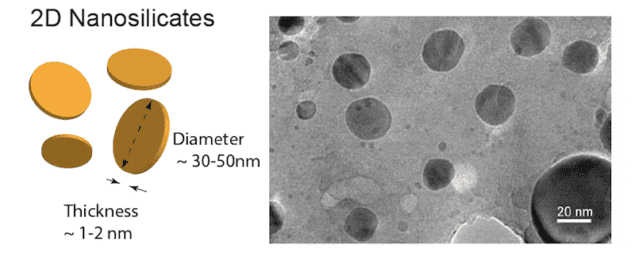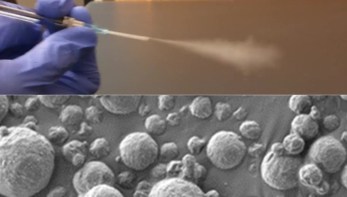
2D nanoparticles known as nanosilicates can be used to grow bone and cartilage tissue from human mesenchymal stem cells, according to new gene sequencing experiments by researchers at Texas A&M University in the US. The finding could help in the development of next-generation bioactive materials for regenerative medicine.
Human stem cells show much promise for regenerative medicine because they can transform into various specialized cell types, including bone and cartilage cells. At the moment, such specialized cells are obtained by subjecting stem cells to specific instructive protein molecules, known as growth factors. However, these factors can produce harmful effects in the body, such as unwanted tissue growth and tumours.
A team led by Akhilesh Gaharwar has now found that 2D nanosilicates (or nanoclays) can be used to grow bone and cartilage tissue in the absence of growth factors. The researchers obtained their result by looking at how the nanoparticles interact with human mesenchymal stem cells (hMSCs) at the whole transcriptome level using a technique called high-throughput sequencing (RNA-seq).
Snapshot of cell gene activity
2D nanomaterials are emerging as ideal structures for making electronics devices for a host of applications, including in energy and optics. However, until now, we did not know how they interact with human stem cells and if indeed, they could be used in biomedical applications.
RNA-seq is a next-generation, highly sensitive sequencing technique that reveals how much RNA there is in a biological sample at a given moment and under a certain condition – in the presence of nanoparticles, for example. “Cell-nanoparticle interactions can produce significant change in cellular behaviour that we can observe using this technique,” explains Irtisha Singh, who is one of the senior authors of this study. “Put simply, RNA-seq takes a snapshot of the gene activity of the cell. It’s rather like taking a high-resolution photo during the Super Bowl and identifying the reaction of every fan during the touchdown.”
Transcriptome dynamics
The researchers employed so-called transcriptome dynamics to discover the biophysical and biochemical pathways that are triggered when 2D nanosilicates interact with hMSCs. “We observed widespread changes in gene expression profiles in more than 4000 genes following nanoparticle exposure, something that had not been reported on previously,” say first authors Jake Carrow and Lauren Cross. “What is more, the technique identifies key genes and enriched gene ontology pathways, as well as categories related to stem cell differentiation – and specifically toward osteochondral lineages (that is, related to bone and cartilage tissue growth).”
The team says that it validated its RNA-seq findings with in vitro studies that back up this result – that nanosilicates can indeed direct the differentiation of hMSCs towards bone and cartilage tissue.
Bone regeneration therapy applications
“Our study shows that hMSCs present signalling typically observed during regeneration of bone and cartilage in the presence of nanosilicates,” Gaharwar tells nanotechweb.org. “This means that these nanoparticles might be used as a possible bone regeneration therapy for osteoarthritis and osteoporosis, among other diseases. We believe that the cellular response to nanosilicates comes from these particles’ unique physical and chemical composition, and their highly bioactive nature, opening the way to a new field of ‘mineralomics’ as an alternative to current stem cell treatments that rely on growth factors.
“Osteoporosis, for example, causes bones to become weak and brittle – so brittle that even mild stresses (such as bending over or coughing) can cause a fracture,” he adds. “2D nanosilicates could come into their own here and help stimulate bone growth. If we can deliver these particles to bone cells, they could encourage bone cells to deposit bone matrix that would strengthen the surrounding weak bone.”
Towards in vivo trials
The nanosilicates could also be used to treat arthritis/osteoarthritis, he says. “Osteoarthritis progressively degrades cartilage and often specifically attacks the spaces between joints,” explains Gaharwar. “Because these intra-articular spaces lack blood vessels, systemic delivery of morphogens and growth factors supporting cartilage matrix synthesis usually results in limited improvement. These nanoparticles could be delivered to this space to stimulate chondrocytes to synthesize new cartilage matrix.”
The present study, which is detailed in PNAS https://doi.org/10.1073/pnas.1716164115, was performed on human cells in vitro. The researchers say that they would now like to show that bone and cartilage tissue grows in the presence of nanosilicates in vivo (in animals such as mice and rats to begin with). “In particular, we are looking to develop implantable scaffolds containing these nanomaterials to improve local tissue growth,” says Gaharwar. “We will also be using computational biology and techniques like genomics to design a next-generation of bioactive materials for regenerative medicine.”



